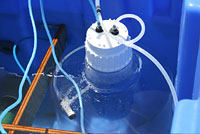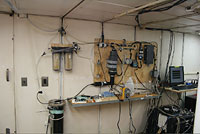

 | |||||||||||||||||||
|
|
Journals 2008/2009Jeff Lawrence
December 12, 2008 Dave Drapeau has set up his experiment on the fantail of the boat to test the effects of differing CO2 levels on the health of the coccolithophores. The base CO2 level, which is concurrent with today's levels, is 380 ppm (parts per million). Dave will test coccolithophore development at this level and at 500 ppm, 750 ppm, and 1200 ppm. The idea is to see what may happen to these important creatures of the ocean and of the earth ecosystem if the current CO2 levels in our atmosphere continue. It is feared that the increased CO2 will make our ocean more acidic and thereby make it harder or impossible for these coccolithophores to form harden shells, which are made of carbon and transported to the bottom of the oceans where they are sequestered as eventually limestone for eons of time. This experiment lasts for 72 hours and will be repeated four more times on the cruise. Marlene is assisting Dave in taking samples from the bottles. Marlene is a scientist from Bermuda and one of many who are sampling the carboys from Dave Drapeau's experiment to determine the effects the increasing CO2 levels may have on coccolithophores.
Other small things that live in the ocean are a keystone species are Copepods. They are tiny shrimp like organisms that live deeper in the ocean in the day time and come to surface at night to feed on phytoplankton. They live deeper when the sun is up to avoid fish and other predators looking for a snack. The ship's underway system is an opening in the bow of the ship that allows water to pass through it. It works when the weather is too rough for the other instruments to go into the water such as the CTD. The water enters the ship and travels to a lab toward the back of the ship where it is sent through filters. A computer then analyzes what is in the water. This night the Copepods decided to show up, no doubt they were looking for a meal of phytoplankton.
Questions of the Day:
|
||||||||||||||||||



